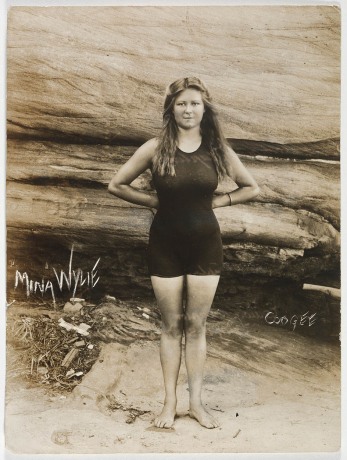Hello November 2016!

Mina Wylie and Fanny Durack were the original dream-team. These two Australian swimming champions were the first women to win medals for swimming at the Olympics and spearheaded mixed bathing on Australian beaches.
November is a month for early morning exercise, beating your own personal best, and supporting others in your field.
Wilhelmina ‘Mina’ Wylie, as your textbook beachy Sydneysider, learned to swim from a young age, joining her diving champion father, Henry, in his aquatic performance act from the age of five. Henry Wylie built and managed the Wylie Baths at Coogee, and it was through swimming at Coogee that Mina crossed lanes with another young swimmer. Sarah Frances Durack, known best as Fanny, taught herself to swim by watching swimmers at the Coogee baths, and soon joined Mina to train every day.

Originally the two swimmers excelled at breastroke -the only swimming stroke permitted for female competitors at the time – but soon switched to freestyle or ‘the Australian crawl.’ Both found success early – Fanny won her first state title in 1906 and in 1908 Mina set a world record for the 100-yards freestyle. However, Mina and Fanny’s careers really hit their ‘stroke’ in 1912, when they attended the Stockholm Olympic Games. This was the first Olympic Games where women were permitted to compete in swimming. However, the New South Wales Ladies’ Amateur Swimming Association (say that ten times fast) had a rule barring women from competing in public with men present – it was considered by many to be indecent and inappropriate. Remember it was only five years earlier that Annette Kellerman was arrested on a US beach for wearing scandalous above-the-knee bathers!

Our watery heroines had such overwhelming public support that the NSWLASA reversed their rule and the funds were raised to send the women to compete at the Games where Fanny won the gold medal and Mina the silver, becoming the first female Olympic medalists in the world for swimming, and the only individual gold for Australia that year. Both Mina and Fanny continued for many years to break swimming records and tour the world, and later in life built successful careers as teachers and mentors for young female swimmers. The two women were lifelong friends as well as rivals.

The shift in Olympic Games policy to include female swimmers marks a shift in attitudes towards women’s bodies in the early twentieth century. Australian society was slowly chipping away at Victorian-era ideals of femininity and the new idea that women could be active, healthy and robust was gaining traction. Mina and Fanny’s careers also sit right on the advent of mixed bathing, which caused great controversy in Australia when it was introduced. Some vocal commentators at the time feared not so much for the femininity of the female swimmers, but their safety. Rose Scott, President of the NSWLASA, feared that mixed bathing would place women in danger of sexual assault. Not only that, it would even put all of the women who didn’t swim at risk, because women in general would suffer a loss of ‘respect’ through this ‘immodest behaviour’.

… wait a second, so it WAS about femininity! Scott’s logic went that if women looked a certain way it would inevitably result in ‘an increasing boldness of the men’. I know what you’re thinking – couldn’t the men simply choose to not sexually assault or make assumptions about the character or consent of a woman based on her clothing? Thank goodness we live in the twenty-first century where all of these issues are now ancient history.
“But what was she wearing?”

Mina and Fanny’s legacy can be seen in Australian 50m freestyle gold medallist Maddison Elliot, Australia’s 2016 gold medal winning 4x100m freestyle team Cate Campbell, Bronte Campbell, Emma McKeon and Brittany Elmslie (as the only two female Australian swimmers Mina and Fanny had offered to swim two legs each so they could compete in the 1912 relay but the Olympic officals didn’t buy it) and Yusra Mardini who swam butterfly in 2016 for the world’s first refugee Olympic team.
One of the most striking aspects of Mina and Fanny’s career is their sense of partnership, supporting each other to push boundaries and break new ground together as a team. This month, take a leaf out of Mina and Fanny’s book and think about how you might partner up with or support a friend/rival/frenemy, so that you can both succeed. Find the Tina to your Amy, the Betty to your Wilma, the Salt to your Pepa, you won’t regret it.
Start swimmin’ summer’s comin’!
Love Dusty xxx
PS…
- Do you all follow Mari Andrew?
- Head to the Coogee Lady Baths AKA McIvers Baths
- Playing this on repeat
- Lupita Nyong’o on Queen of Katwe
Bibliography
She’s Game: Women Making Australian Sporting History
Australian Dictionary of Biography – Fanny Durack
Australian Dictionary of Biography – Mina Wiley
SBS Australia
Fanny Durack Aquatic Centre
Image credits: Ashton Malcolm, State Library of NSW, National Museum Australia, Wiki Commons, State Library of Victoria, State Library of South Australia
